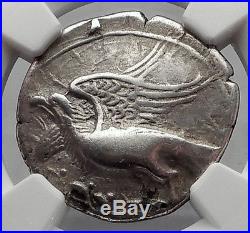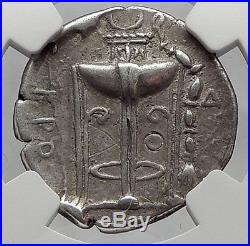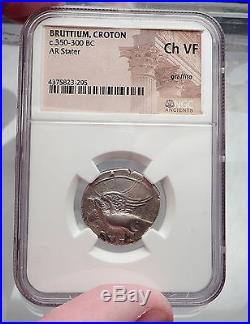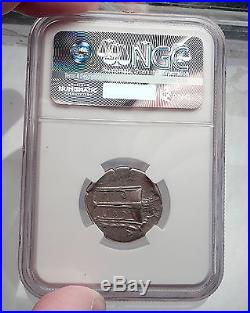




Item: i60198 Authentic Ancient Coin of. Greek city Kroton in Bruttium Silver Stater / Nomos 23mm (7.65 grams) Struck circa 350-300 B. Reference: SNGANS-362; HNItaly-2172 Certification: NGC Ancients Ch VF 4375823-295 Eagle standing left atop olive branch. Tripod altar, KPO in field to left; in field to right. Kroton suffered greatly from attacks by Dionysios I of Syracuse in early part of the 4th Century, and later was invovled in continual warfare with the Bruttians: captured by Agathokles of Syacuse in 299 B. And finally fell to the Romans twenty-two years later. A sacrificial tripod was a type of altar used by the ancient Greeks. The most famous was the Delphic tripod , on which the Pythian priestess took her seat to deliver the oracles of the deity. The seat was formed by a circular slab on the top of the tripod, on which a branch of laurel was deposited when it was unoccupied by the priestess. In this sense, by Classical times the tripod was sacred to Apollo. The mytheme of Heracles contesting with Apollo for the tripod appears in vase-paintings older than the oldest written literature. The oracle originally may have been related to the primal deity, the Earth. Another well-known tripod was the Plataean Tripod , made from a tenth part of the spoils taken from the Persian army after the Battle of Plataea. This consisted of a golden basin, supported by a bronze serpent with three heads (or three serpents intertwined), with a list of the states that had taken part in the war inscribed on the coils of the serpent. The golden bowl was carried off by the Phocians during the Third Sacred War ; the stand was removed by the emperor Constantine to Constantinople (modern Istanbul), where it still can be seen in the hippodrome , the Atmeydan , although in damaged condition, the heads of the serpents disappeared however one is now on display at the nearby Istanbul Archaeology Museums. The inscription, however, has been restored almost entirely. Such tripods usually had three ears (rings which served as handles) and frequently had a central upright as support in addition to the three legs. Tripods frequently are mentioned by Homer as prizes in athletic games and as complimentary gifts; in later times, highly decorated and bearing inscriptions, they served the same purpose. They also were used as dedicatory offerings to the deities, and in the dramatic contests at the Dionysia the victorious choregus (a wealthy citizen who bore the expense of equipping and training the chorus) received a crown and a tripod. He would either dedicate the tripod to some deity or set it upon the top of a marble structure erected in the form of a small circular temple in a street in Athens , called the street of tripods, from the large number of memorials of this kind. One of these, the Choragic Monument of Lysicrates , erected by him to commemorate his victory in a dramatic contest in 335 BC , still stands. The form of the victory tripod, now missing from the top of the Lysicrates monument, has been rendered variously by scholars since the eighteenth century. The scholar Martin L. West writes that the sibyl at Delphi shows many traits of shamanistic practices, likely inherited or influenced from Central Asian practices. He cites her sitting in a cauldron on a tripod, while making her prophecies, her being in an ecstatic trance state, similar to shamans, and her utterings, unintelligible. According to Herodotus The Histories, I. 144, the victory tripods were not to be taken from the temple sanctuary precinct, but left there for dedication. Crotone is a city and comune in Calabria , southern Italy , on the Ionian Sea. Founded circa 710 BC as the Achaean colony of Croton Greek. , it was known as Cotrone from the Middle Ages until 1928, when its name was changed to the current one. In 1994 it became the capital of the newly established Province of Crotone. As of July 2007, its population was 61,032. Croton was long one of the most flourishing cities of Magna Graecia. Its inhabitants were famous for their physical strength and for the simple sobriety of their lives. From 588 BCE onwards, Croton produced many generations of victors in the Olympics and the other Panhellenic Games , the most famous of whom was Milo of Croton. According to Herodotus (3.131), the physicians of Croton were considered the foremost among the Greeks, among which Democedes son of Calliphon was the most prominent in the 6th century BCE Accordingly, he traveled around Greece and ended up working in the court of Polycrates, tyrant of Samos. After the tyrant was murdered, he was captured by the Persians and brought to King Darius, curing him of a dislocated ankle. Democedes fame was, according to Herodotus, the one who prompted the prestige of Croton’s physicians. Pythagoras founded his school, the Pythagoreans , at Croton circa 530 BCE. Among his pupils were the early medical theorist Alcmaeon of Croton and the philosopher, mathematician, and astronomer Philolaus. The Pythagoreans acquired considerable influence with the supreme council of one thousand by which the city was ruled. Sybaris was the rival of Croton until 510 BCE, when Croton sent an army of one hundred thousand men, commanded by the wrestler Milo , against Sybaris and destroyed it. Shortly afterwards, however, an insurrection took place, by which the Pythagoreans were driven out and a democracy established. It was replaced by Heraclea as headquarters of the Italiote League. Dionysius , the tyrant of Syracuse , aiming at hegemony in Magna Graecia, captured Croton in 379 BC and held it for twelve years. Croton was then occupied by the Bruttii , with the exception of the citadel, in which the chief inhabitants had taken refuge; these, being unable to defend the place against a Carthaginian force, soon after surrendered, and were allowed to withdraw to Locri. In 295 BCE, Croton fell to another Syracusan tyrant, Agathocles. When Pyrrhus invaded Italy (280-278, 275 BCE), Croton was still a considerable city, with twelve miles of walls, but after the Pyrrhic War , half the city was deserted (Livy 24.3). What was left of its population submitted to Rome in 277 BC. After the Battle of Cannae in the Second Punic War (216 BC), Croton revolted from Rome, and Hannibal made it his winter quarters for three years; it was not recaptured until 205 or 204 BCE. In 194 BCE, it became the site of a Roman colony. Little more is heard of it during the Republican and Imperial periods, though the action of one of the more significant surviving fragments of the Satyricon of Petronius is set in Croton. Around 550, the city was unsuccessfully besieged by Totila , king of the Ostrogoths. At a later date it became a part of the Byzantine Empire. About 870 it was sacked by the Saracens , who put to death the bishop and many people who had taken refuge in the cathedral. Over a hundred years later, Otto II, Holy Roman Emperor , mounted a campaign in southern Italy to reduce the power of the Byzantines. Later on Cotrone was conquered by the Normans. Thereafter it shared the fate of the Kingdom of Naples including the period of Spanish rule of which the 16th-century castle of Charles V , overlooking modern Crotone, serves as a reminderand its successor, the Kingdom of the Two Sicilies , which was conquered by the Kingdom of Sardinia in 1860 and incorporated into the new Kingdom of Italy in 1861. Crotone’s location between the ports of Taranto and Messina , as well as its proximity to a source of hydroelectric power, favored industrial development during the period between the two World Wars. In the 1930s its population doubled. However, after the two main employers, Pertusola Sud and Montedison , collapsed by the late 1980s, Crotone was in economic crisis, with many residents losing their jobs and leaving to find work elsewhere. In 1996, a flood dealt a further blow to the city’s morale. Since that low point, the city has undergone urban renewal and risen in quality-of-life rankings. The Cathedral, originally from the 9th-11th century, but largely rebuilt. It has a neo-classical façade, while the interior has a nave with two aisles, with Baroque decorations. Noteworthy are a baptismal font (12th century) and the Madonna di Capo Colonna , the icon of the Black Madonna which, according to the tradition, was brought from East in the first years of the Christian era. The 16th century Castle of Charles V. It houses the Town Museum, with findings excavated in the ancient site of Kroton. Notables are also the remnants of the walls, of the same century, and of various watchtowers. The ancient castle built on an island, with accessibility on foot limited to a narrow strip of land, is referred to as Le Castella. Crotone also has a railway station, although much of the tourism traffic is served by the Salerno-Reggio Calabria highway and the National Road (called 106 Ionica) leading all the Jonic (eastern) coast from Taranto to Reggio Calabria. In recent time Crotone Port has been used by visitors on yacht charter cruising vacations. Croton hosts a national archaeological museum, a municipal museum, a municipal art gallery, and a provincial museum of contemporary art, as well as the Antiquarium di Torre Nao. Ilya Zlobin, world-renowned expert numismatist, enthusiast, author and dealer in authentic ancient Greek, ancient Roman, ancient Byzantine, world coins & more. Ilya Zlobin is an independent individual who has a passion for coin collecting, research and understanding the importance of the historical context and significance all coins and objects represent. Send me a message about this and I can update your invoice should you want this method. Getting your order to you, quickly and securely is a top priority and is taken seriously here. Great care is taken in packaging and mailing every item securely and quickly. What is a certificate of authenticity and what guarantees do you give that the item is authentic? You will be very happy with what you get with the COA; a professional presentation of the coin, with all of the relevant information and a picture of the coin you saw in the listing. Additionally, the coin is inside it’s own protective coin flip (holder), with a 2×2 inch description of the coin matching the individual number on the COA. Whether your goal is to collect or give the item as a gift, coins presented like this could be more prized and valued higher than items that were not given such care and attention to. Is there a number I can call you with questions about my order? When should I leave feedback? Please don’t leave any negative feedbacks, as it happens sometimes that people rush to leave feedback before letting sufficient time for their order to arrive. The matter of fact is that any issues can be resolved, as reputation is most important to me. My goal is to provide superior products and quality of service. How and where do I learn more about collecting ancient coins? Visit the “Guide on How to Use My Store” for on an overview about using my store, with additional information and links to all other parts of my store which may include educational information on topics you are looking for. You may also want to do a YouTube search for the term “ancient coin collecting” for educational videos on this topic. The item “KROTON BRUTTIUM 350BC Original Silver Ancient Greek Coin Eagle Tripod NGC i60198″ is in sale since Monday, March 20, 2017. This item is in the category “Coins & Paper Money\Coins\ Ancient\Greek (450 BC-100 AD)”. The seller is “highrating_lowprice” and is located in Rego Park, New York. This item can be shipped worldwide.
- Certification: NGC
- Certification Number: 4375823-295
- Grade: Ch VF
- Culture: Greek
- Coin Type: Ancient
- Composition: Silver
- Material: Silver
